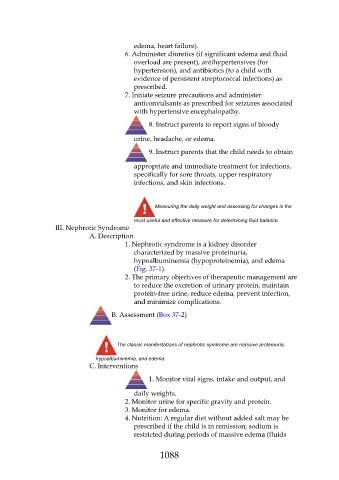Page 1088 - Saunders Comprehensive Review For NCLEX-RN
P. 1088
edema, heart failure).
6. Administer diuretics (if significant edema and fluid
overload are present), antihypertensives (for
hypertension), and antibiotics (to a child with
evidence of persistent streptococcal infections) as
prescribed.
7. Initiate seizure precautions and administer
anticonvulsants as prescribed for seizures associated
with hypertensive encephalopathy.
8. Instruct parents to report signs of bloody
urine, headache, or edema.
9. Instruct parents that the child needs to obtain
appropriate and immediate treatment for infections,
specifically for sore throats, upper respiratory
infections, and skin infections.
Measuring the daily weight and assessing for changes is the
most useful and effective measure for determining fluid balance.
III. Nephrotic Syndrome
A. Description
1. Nephrotic syndrome is a kidney disorder
characterized by massive proteinuria,
hypoalbuminemia (hypoproteinemia), and edema
(Fig. 37-1).
2. The primary objectives of therapeutic management are
to reduce the excretion of urinary protein, maintain
protein-free urine, reduce edema, prevent infection,
and minimize complications.
B. Assessment (Box 37-2)
The classic manifestations of nephrotic syndrome are massive proteinuria,
hypoalbuminemia, and edema.
C. Interventions
1. Monitor vital signs, intake and output, and
daily weights.
2. Monitor urine for specific gravity and protein.
3. Monitor for edema.
4. Nutrition: A regular diet without added salt may be
prescribed if the child is in remission; sodium is
restricted during periods of massive edema (fluids
1088

